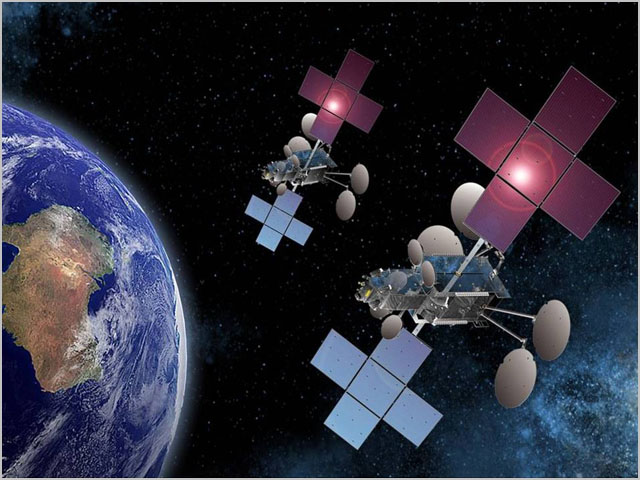news Rural and remote Australian communities will eventually be able to enjoy access to high-speed Internet not previously accessible, with the National Broadband Network Company (NBN Co) this week choosing Space Systems/Loral (SS/L) to build two next-generation Ka-band satellites to cover the regions.
According to a statement issued by the company yesterday, NBN Co plans to launch the satellites in 2015, to provide high-speed broadband coverage to about three per cent of premises that fall outside the reach of the NBN’s planned fibre optic and fixed-wireless services. The locations include outback areas and Australia’s external territories such as Norfolk Island, Christmas Island, Macquarie Island and the Cocos Islands.
SS/L is a leading manufacturer of commercial broadband satellites, and it has produced the largest number of commercial Ka-band satellites globally. It is a subsidiary of Loral Space and Communications, and provides spacecraft for a wide range of services including television and radio distribution, digital audio radio, broadband Internet and mobile communications. The company has 67 satellites in orbit and 23 under construction, including both broadband and other categories of satellites.
NBN Co’s contract is valued at roughly $620 million and ensues after a comprehensive two-year procurement process carried out by the company. The contract forms part of a total investment of approximately $2 billion required to deliver the NBN Long Term Satellite Service (LTSS). Under the terms of the contract, SS/L will also provide associated telemetry, tracking and command systems for NBN Co’s LTSS.
The LTSS is designed to provide a basic download speed of up to 12Mbps at the wholesale level, which is the same basic speed and AVC access price ($24 per month) across fibre, satellite and wireless. The LTSS is part of NBN Co’s plan to build an integrated national network that will utilise fibre, satellite and wireless technologies.
Two more tenders for the delivery of other components of the LTSS will be awarded soon. NBN Co is appraising supplier submissions for the construction of satellite ground systems and will release a tender within the next few months for the launch of the SS/L satellites into orbit. The plan is for the satellites and ground-based control systems to be delivered over the next 41 months. The first satellite will be launched in early 2015 and the second in the latter half of the same year.
Instead of splitting capacity between several other tasks including satellite phones and broadcast television or providing services in other countries, the new Ka-band satellites will use multiple high-capacity beams intended to maximise the efficiency of the broadband service specifically for Australia.
Meanwhile, NBN Co is operating an Interim Satellite Service that it had established to enable the transition from the Commonwealth’s Australian Broadband Guarantee program to the LTSS. The Interim Satellite Service provides download speeds of up to 6 Mbps to retail service providers, with over 2500 premises already connected.
Mike Quigley, NBN Co’s chief executive officer said: “NBN Co’s satellites have been designed to deliver initial peak speeds of 12/1 Mbps at the wholesale level for the same wholesale access price as similar fibre services. It will be possible for retail service providers to offer services to homes and businesses in the satellite footprint that are as good or better than the services many city people currently experience.”
Quigley explained that NBN Co is providing an open access network to facilitate competition among retail service providers, since the provision is on a non-discriminatory basis. He believes that this could potentially enable lower pricing and innovation for consumers – including those in geographically isolated areas.
Speaking about NBN Co’s and SS/L’s shared commitment to excellent performance and highest quality service, John Celli, president of Space Systems/Loral said: “We’re delighted to play a part in helping to deliver much-needed high-speed broadband services to communities in regional and remote areas.”
Image credit: NBN Co


Download speed are about consuming content. Boring business as usual enabler. In the digital economy, its your upload speed that is critical – producing content is where you build value. Satellites only allow for ‘up to’ 1mbps. Compare this to a FTTH connection and it doesn’t take long to realise that a new form of poverty is in the process of being invented for remote Australians.
Can I ask what the alternative is? Genuine question.
Strong language, David Nixon; one might say even bordering on the mildly hysterical. “[A] new form of poverty is in the process of being invented”? That’s almost Godwin-esque.
Yes, the asymmetrical speeds are not perfect. It would be wonderful to have FTTH capacity to every shack and hamlet along every dusty track – because that IS what we’re talking about here. The 3% most remote residences in Australia. The cost to fibre them up would be staggering – I’ve seen estimates where the total cost of the NBN rollout would be tripled or even more. Pray tell, what is your alternative, as David Robinson adroitly asks?
The question I’d like to know is where are they going to get the satellite controllers from?
That is a pretty specific job and there are only a handful of earth stations currently in the country, are they going to poach these people from other companies or is this going to be a place where NBN Co imports talent?
Tezz, they won’t be required for some time, plenty of time to upskill people. There will be redundancies and this would be an opportunity
umm.. this is not a field that you “upskill” people into. Remember I’m not talking about the people who maintain the services, I’m talking about the people who maintain the satellites themselves.
Their position is unique in that the equipment they manage is extremely expensive, and that it isn’t easily accessible for when things go wrong.
For reference I did a quick google search and here’s a couple of jobs currently going, note the experience specifics (that’s not training time, that’s required on the job working time).
https://sjobs.brassring.com/1033/ASP/TG/cim_jobdetail.asp?jobId=852364&partnerid=25326&siteid=5443&codes=IND
http://jobs.saic.com/job/Scott-Afb-Network-ControllerOperator-Job-IL/1709630/?feedId=4&utm_source=Indeed
Comments are closed.